In defense of fog
Today I must go without a flashbulb, stand in the center of its inner and outer manifestation, and discover how my grey-day grey-matter, matters.
Today, I am in a fog squared. Oregon’s damp blanket has finally thrown itself over summer while my brain also slumbers with low clouds. Outside my window, tree limbs blur within a grey gauze. The sky pulls wool over my eyes, fooling the me who is someone with something to say and somewhere to go. While sailors navigate safely to shore with fresnel lighthouses and fog horns, my own synapses are stranded at sea with no compass. I sit on a bobbing life raft and wait it out, sighting an occasional horizon, only to… disappear… mid-... It’s blurry in here and my perfectionist doesn’t approve. She demands: Turn on the high-beams. Down caffeine. Stand on your head. Pop Adderall. Push through. Fog is heavy, fog delays, fog obscures and it’s hard to think from inside this dank miasma let alone write.
But to save this exploration until I’m firing on all cylinders would be to photograph fog’s beauty after it has lifted. Today I must go without a flashbulb, stand in the center of its inner and outer manifestation, and discover how my grey-day grey-matter, matters.1 If the California Redwoods have become mighty not by rain but by fog2, can it too, sustain me?
I spent a lot of my early years in a fog. I recently learned that if beloved author
could create a new genre, it would be called kitchen drama—stories centered on the everyday domestic scenes where “the richness of frustration and desperation and anger and hurt and love” all take place. When she shared this in a recent interview with , I asked myself, What room in the house has my drama lived?Not a moment to edit myself, I blushed with knowing—bathroom drama is my genre. Though it would’ve never played well for an audience; this was a one-woman show, her drama largely played out on a fog-spewing inner stage. With an insignificant amount of time actually “going to the bathroom,” much of my childhood, teen and young adult years lived in the loo where my desperation and hope were mirrored by glass and circled the drain. A locked door refuge, the bathroom was a boundary on this world and an invitation into another, where the din of my angst was the only angst; I’d space out to hear my space within.In mom and dad’s bath, while morning light scraped across the room, I’d sit on the toilet lid and mirror-neuron dust mote ennui. After school, the hallway half-bath was my chosen solitary confinement. Resting my chin in hands, I’d watch the tile floor bloom and shrivel, bloom and shrivel—a time-stopping mosaic of caulk and clay—my brain in between channels listening for my own. I spent my teen years in the guest room bath, picking away at perfectionism and longing for a freer me to surface. And as a young adult I’d purge angst at the porcelain throne, confusing emptiness for peace, and say no to the world when my body no longer could. In these bathroom scenes I beseeched my undone self, Who am I? What is my purpose? And below the compulsions, I was seconds from an answer. In my zero-visibility, I was reckless but honest. Alone but abiding. Listening for what lay untold and calling for a timid, but truer truth.
And while some zoning out can be a sign of trauma, sleep deprivation, over-stimulation or a more serious medical condition, there are also studies that show how a brain on autopilot can be a necessary refresh and enhance creativity. As author Andrew Smart notes in his book Autopilot: The Art and Science of Doing Nothing, ”Neuroscientific evidence argues that your brain needs to rest, right now. While our minds are exquisitely evolved for intense action, in order to function normally our brains also need to be idle—a lot of the time, it turns out.” Like swishing a gauzy net around a pond, spacing out can surface “great ideas buried in your unconsciousness,” so with bathroom dramas behind me and a more playful obscurity on my brain, I ask not Who am I, but What color am I? What shape is my name? The same synaptic-fuzz answers but this time its smiles and invites you to join.
The stoner surfer dude of meteorology, fog is happy to hang: time, direction and perception suspends and shape-shifts in a vaporous haze. Turning away from our binary, visually dominated world, it invites us to perceive verity through hidden and intermingled realms. While I tap on my keyboard, my mind wanders away in search of this truth, seeping through the back door into thick, atmospheric droplets; I hang heavy and listen, not just with ears, but with a different sense altogether: ears plus eyes plus skin plus nose are equal to but less than presence-sensing—presense with an “s”! Just under my feet, damp, loamy soil teems with happy worms, their supple bodies already know what I seek. Author Ed Yong, in his bestselling An Immense World, describes, “An animal’s sensory world is the result of solid tissues that detect real stimuli and produce cascades of electrical signals. It is not separate from the body, but of it…There are animals with eyes on their genitals, ears on their knees, noses on their limbs, and tongues all over their skin. Starfish see with the tips of their arms, and sea urchins with their entire bodies.”
My senses applaud and lick the damp air. So many tongues all around me! Ferns, trees, and moss have all adapted to drink the small droplets in fog for their water needs, sometimes fully rehydrating a plant’s leaves and sustaining entire coastal ecosystems, including the animals that rely on them for shelter and food. Topsoil also has his tongue out on a foggy day, lapping up the moisture to reduce surface dehydration and protect the friendly bacteria, nematodes, earthworms and mycorrhizal communities below.3 And mushrooms—don’t even get me started. Like one giant tongue, a mushroom’s fruiting body is mostly water and will begins to shrivel in humidity less than 90%. And just when you think you’ve had enough tongue, fog licks back—it’s a French kissing orgy out here—tiny molecules of water washing the air clean from fumes, particles, and airborne contaminants. Go ahead, stick your tongue out and join us. The fog might lick you too.
When I’m foggy I think more like a tree and listen more like a leaf. And if I surrender my need for it to be any other way, it’s quite lovely being tree and leaf. So I step into the fog and the fog steps into me. No hard lines, only voluminous shadows forgetting their form. My hand reaches toward the blurry shape of a deer and we erase into one another. There is no threat, the fog blankets our nerves. Stay here, you are safe, it whispers. Eyes less reaching, more landing. The hazy highlighter accentuates color over shape, here over there, now over next. Synesthesia straddles inner and outer and habitual awareness surrenders to something more porous, and then peculiar, and then enlivening, surprising an “aha” that far surpasses my mind’s conjuring. I become undifferentiated. My body and her surrounds one giant quilt of criss-crossed, perceptual awareness; our breath, her seams.
Fog fills my ears with cotton. High-frequencies retreat and waves navigate slowly or not at all. Instead of a ten-track song, fog mutes all but one. My thoughts, empty. The car driving by, dead. My self, indecipherable in the mist. I hear only the drop, drop, drop of life in singular rest. So I, too, sing rest.
Though it’s easy to fall sleepy in this dense dissolving, a part of me is profoundly awake. When author Ingrid Rojas Contreras developed amnesia, a different but not dissimilar kind of inner fog, she found the void comforting and alive with truth. In her spell-binding memoir The Man Who Could Move Clouds she writes, “According to our indexes of meaning, amnesia is ignorance, and this state of pragmatic awareness is knowledge; but everything was incandescent when I had no memory of what things were… I knew so much more then, during amnesia. So it can begin to seem that this state of awareness is ignorance, and that that state of amnesia was knowledge.” While wandering the streets of Chicago without a self to wander, a psychiatrist may’ve diagnosed her with Dissociative Fugue, but I prefer Integrative Fog. Undifferentiated, everything became knowable as never before; she drowned separate but surfaced whole. Who am I? refines to am I? and is answered with a simple. resolute. am.
Fear interjects. Is my brain surrendering to the deep? Am I unbraining? Like many people living with chronic illness and pain, brain fog is a normal part of life.4 I once heard it described as “like trying to load Netflix on dial up internet on a windows 98 computer.” Loading…still loading. Processing is slow and once the connection is made, the reason lost. Or maybe recall isn’t sharp, forcing us to substitute words. I see a snake and think danger noodle. Or put my socks in the trash and take out the laundry. It’s easy to fall into anxious frustration when fog descends; clarity and differentiation are evolutionary, survival requires to know self from other and learn from our past mistakes. In other words, it sucks to forget. Etymologists exemplify its threat—from the Scandinavian fog, “a thick, obscuring, mist,” to the Icelandic fuki, “rotten sea grass,” fog obfuscates, fog obliterates. Maybe even John Fogarty of Creedence Clearwater Revival feels its weight, his surname from the Old Irish word fogartch, meaning "banished." When my brain enters the brume, I can’t help but wonder, am I next?
Our identity is composed of narratives constructed from personal history. What happens when we can no longer hold our experiences long enough to string them together? Mom says she’s been feeling foggy lately. After five general anesthesia surgeries over the last two years, it’s probable she’s experiencing post-anesthesia cognitive dysfunction. Look it up, it’s a thing: Among patients aged 65 years and older, up to an 65% experience delirium and 10% develop long-term cognitive decline after surgery.5 Mom, for 78 years was sharp as a tack, running circles around me, always learning, citing this new study or that historical event. If I was a cosmic void, she was my galaxy, birthing bright stars of knowledge into my emptiness. But aging flirts with nothingness. Impermanence promises banishment. Thoughts like helium balloons lift away from her grasp, sometimes with only a lingering sense of intent or origin.
We enter into this world with a great forgetting; is our last-act-forgetting actually a remembering? Mom’s inner fog startles me; sometimes I feel lonely in its perceived vacancy but when I go outside to stand in its center, to feel my own edges dissolving, I clearly unsee—she’s not empty, she’s overflowing, she’s not disappearing, she’s everything.
I sit on a bench (beside her) fog—both in and out dimming separatness and pretzel-armed leaning— our bond no longer scythed by thought (or cut umbilicus) and release our grip one balloon one concept one belief at a time we see, hear, taste, touch are formless color unnaming the know I squeeze her hand—my touch (selfing and unselfing) while fog like our love smudges us whole
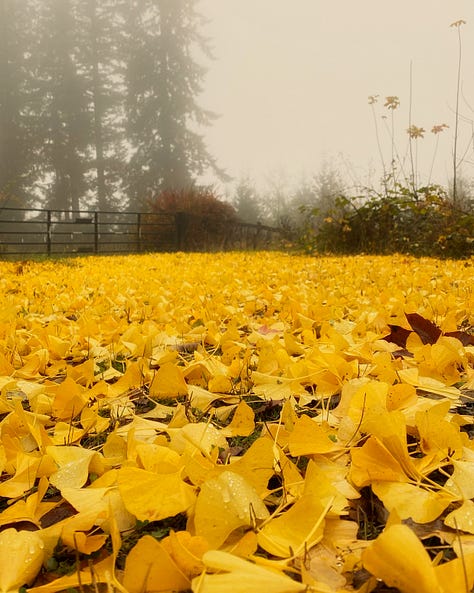
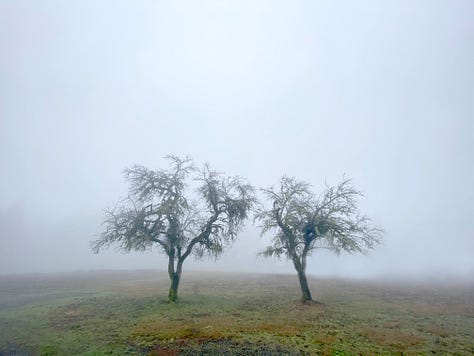
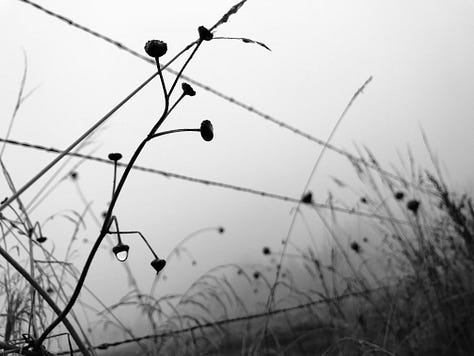
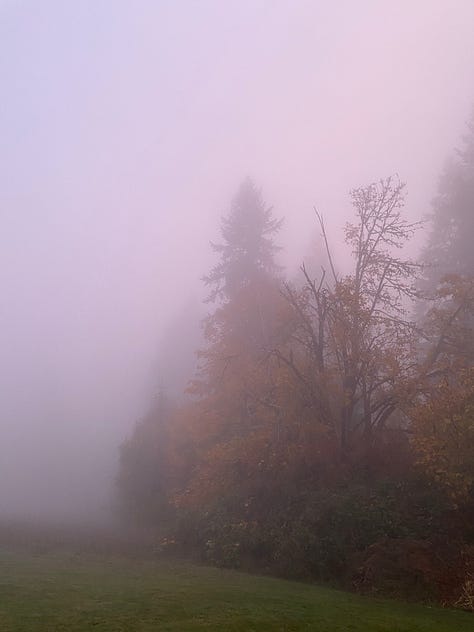
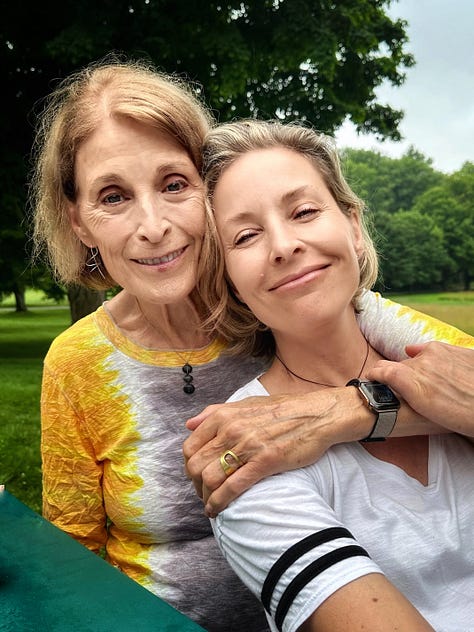
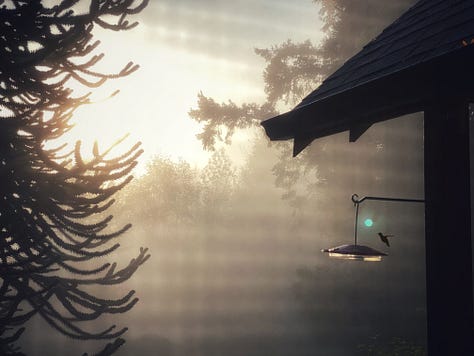
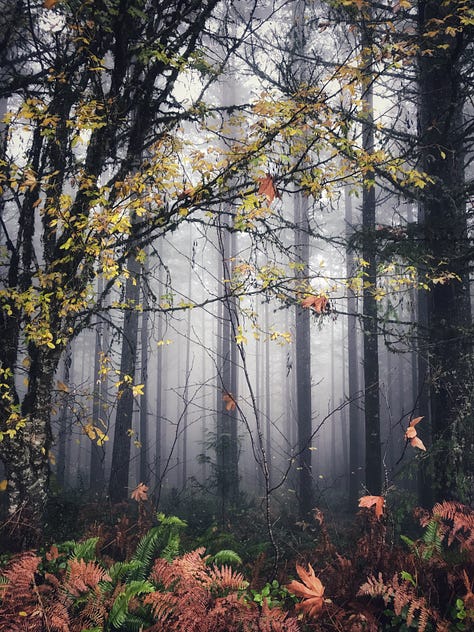
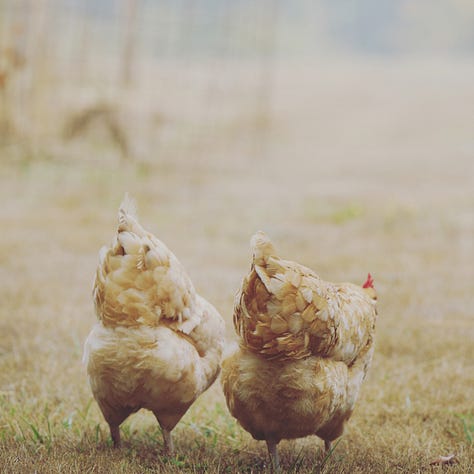
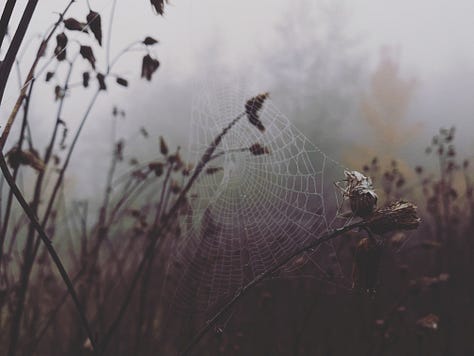
This exercise has proven difficult. Thank you for patiently allowing me to lead you into the mist.
Fog sustains redwoods and the ecosystems they support, including life in the creek. Specialized redwood tree needles catch the fog. The fog drips down through the canopy and replenishes the water in the creek. Redwoods get up to 40% of their water from fog each year!
https://environment.sfsu.edu/sites/default/files/2022-05/Baguskas-etal-Coastal-low-cloudiness-and-fog-increase-WUE-of-crops-AFM-2018.pdf
Vestibular patients almost unanimously report brain fog. I’ll be sharing this entire series soon, but if you want to learn more, in Episode 2: Mind Rebalanced nine individuals describe what it’s like to live within a miasmic blur.
https://www.ncbi.nlm.nih.gov/pmc/articles/PMC8807795/



Kimberly, what a divine witchery of words you conjure in your fog.
Here "When I’m foggy I think more like a tree and listen more like a leaf. And if I surrender my need for it to be any other way, it’s quite lovely being tree and leaf. So I step into the fog and the fog steps into me. No hard lines, only voluminous shadows forgetting their form. My hand reaches toward the blurry shape of a deer and we erase into one another." you mirror how those grey days matter to the grey matter so precisely I feel as though I wrote them myself. I didn't and couldn't as eloquently but wish, oh how I wish... on the bright side, my vocabulary expands!
Your last paragraph too, thoughts I have been pondering deeply during these, perhaps my last, in my present state... "—she’s not empty, she’s overflowing, she’s not disappearing, she’s everything." I hope, I pray, I am.
Thank you always and always - with or without fog, for your insightful messages of transition. xx
fog could have no better defense in your own uniquely capable (and literate my god what words i learned) hands-- artistic questing and sensibility of this sort is a gift
don't ever let me "forget" to remind you of that 🤗🙏